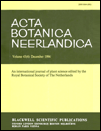DISEASES AND LOPPING FOR FODDER AS POSSIBLE CAUSES OF A PREHISTORIC DECLINE OF ULMUS
H. M. HEYBROEK
Korte Mededeling Nr. 54 of the Forest Research Station “De Dorschkamp”, Wageningen; Mededeling Nr. 41 of the Phytopath. Lab. “Willie Commelin Scholten”, Baarn, Netherlands
Search for more papers by this authorH. M. HEYBROEK
Korte Mededeling Nr. 54 of the Forest Research Station “De Dorschkamp”, Wageningen; Mededeling Nr. 41 of the Phytopath. Lab. “Willie Commelin Scholten”, Baarn, Netherlands
Search for more papers by this authorAbstract
This paper contributes some data to the discussion about the decline of Ulmus in pollendiagrams from many parts of Europe at about 3000 B.C. It is shown that this decrease most probably was not caused by any known disease or pest of elm. Another explanation for the decline is lopping for fodder. Data about this industry are given from recent and historical times, from Europe as well as from the Himalayas. Lopping is a common phenomenon, essential to husbandry in many places. It may even lead to local extermination of a species. U. glabra might be affected more than U. carpinifolia.
REFERENCES
- Anon. 1947. The use and misuse of shrubs and trees as fodder. Imp. Agric. Bur., Joint Publ. 10.
- Bobek, H. 1951. Die natürlichen Wäalder und Gehölzfluren Irans. Bonner Geogr. Abh. 8: 1–62.
- Bolaños, M. M. 1960. Las plantas leñosas en la alimentación y pastorea de la ganadería española. Montes 16: 347–351.
- Brockmann-Jerosch, H. 1918. Das Lauben und sein Einfluss auf die Vegetation der Schweiz. Mitt. Geogr. Ethnogr. Gesells. Zürich 1917/18, 18: 131–150.
- Buberl, M. 1895. Ueber die zukünftige Bewirtschaftung der Karstwälder. Centralblatt f.d. ges. Forstw. 21: 351–357.
- Chevalier, A. 1942. Les ormes de France. Revue de bot. appl. 22: 429–459.
- Dodonaeus (or Dodoens, D. Rembert). 1554. Cruijdeboeck. 1st ed. 1554, 2nd ed. 1563, 3rd ed. 1608.
- de Monceau, Duhamel M. 1768. La Physique des Arbres. Liv. V: 339.
- Duthie, J. F. 1894. Report on a botanical tour in Kashmir, 1893; Records Bot. Survey India 1: 25–47.
- Evelyn, J. 1664. Silva.
- Faegri, K. 1940. Quartärgeologische Untersuchungen im westlichen Norwegen. Bergens Mus. Aarbok 1939–40. Naturv. rekke 7.
-
Faegri, K.
1944. On the introduction of agriculture in Western Norway.
Geol. Fören. Förhandl. 66: 449–462.
10.1080/11035894409445688 Google Scholar
- Gerarde, J. 1597. Herball.
- Geschwind, A. 1917. Die Blumeneschenkultur im Karste. Centralblatt f.d. ges. Forstw. 18: 91–107.
- Geschwind, A. 1920. Die Technik der Wesselyschen Resurrektionshiebe in den Laubholzkrüppelwaldresten des Karstes. Centralblatt f.d. ges. Forstw. 46: 193–218.
- Goidanich, G. 1937. Das Ulmensterben in Italien. Zeits.f. Pflanzenkrankh. 47: 417–425.
- Guyan, W. U. 1955. Das jungsteinzeitliche Moordorf von Thayngen-Weier. In: Das Pfahlbauproblem. Basel: 223–272.
- Hafsten, U. 1956. Pollenanalytical Investigations on the Late Quaternary Development in the inner Oslofjord Area. Univ. Bergen, Aarbok 1956, Naturvit. Raekke 8.
- Iversen, J. 1941. Landnam i Danmarks Stenalder. Geol. Surv. Denmark II, no. 66.
-
Iversen, J.
1944. Viscum, Hedera and Ilex as Climate Indicators.
Geol. För. Forh.
66: 463–483.
10.1080/11035894409445689 Google Scholar
- Iversen, J. 1960. Problems of the Early Post-Glacial Forest Development in Denmark. Geol. Surv. Denmark IV, Vol. 4, no. 3.
- Liese, J. 1952. Pflanzenphysiologische Betrachtungen zum Ulmensterben. Archiv f. Forstwesen 1: 59–70.
- De Lobel, M., 1581. Cruydtboeck, Antwerpen.
- Louis, H. 1939. Das natürliche Pflanzenkleid Anatoliens. Geogr. Abh., III. Reihe. Heft 12: 1–132.
- Marhula, J. 1884. Futterlaubgewinnung in den Landeswäldern des Occupationsgebietes. Oest. Forst.-u. Jagdzeitung 1884: 238–239.
- Mascall, L. 1633. The government of cattell.
- Nordhagen, R. 1954. Om barkebrød og treslaget aim i kulturhistorisk belysning. Geol. Surv. Denm. II, no. 80.
- Pees, A. 1960. Economie forestière de la côte basque. Ann. Ecole Nat. Eaux For. 17: 379–450.
- Petrović, D. S. 1936. Die Bedeutung und Einrichtung der Futterlaubwälder. Actes du lie Congrès Intern, de sylvic., Budapest, 2e vol.: 510–525.
- Price, U. 1786. On the bad effect of stripping and cropping trees. Annals Agric. 5: 241–250.
- Rancken, T. 1953. Asken. In: T. Arnborg and I. Hustich: Våra Trëd. Stockholm.
- Rovski, V. M. 1956. On a radical method of fighting the Dutch elm disease. Botan. Zurn. 41: 1478–1481.
- Russell, F. C. 1947. The chemical composition and digestibility of fodder shrubs and trees. IN: (Anon.) The Use and Misuse of Shrubs and Trees as Fodder, Joint Publ. 10: 185–231.
-
Smith, A. G.
1960. The Atlantic-Subboreal Transition.
Proc. Linn. Soc.
172: 38–49.
10.1111/j.1095-8312.1961.tb00864.x Google Scholar
- Spierenburg, D. 1922. Een onbekende ziekte in de iepen II. Versl. Meded. Plantenziektenk. Dienst 24: 1–31.
- Spierenburg, D. 1929. Eenige oude gegevens over ziekten in boomen (voornamelijk in iepen). Tijds. o. Planteziekten 35: 289–312 and: Mededeling nr. 60, Plantenziektenkundige Dienst.
- Troels-Smith, J. 1953. Ertebøllekultur — Bondekultur. Aarbøger Nord. Aldk. Hist., København: 5–62.
- Troels-Smith, J. 1955. Pollenanalytische Untersuchungen zu einigen schweizerischen Pfahlbauproblemen. In: Das Pfahlbauproblem. Basel: 11–58.
- Troels-Smith, J. 1960. Ivy, Mistletoe and Elm: Climate Indicators-Fodder Plants. Geol. Surv. Denmark IV, vol. 4, no. 4.
- Ve, S. 1930. Skogtraeernes forekomst og høidegrenser i Aardal. Medd. Vestlandets Forstl. Forsøks-st. Bd. 4, H. 3, Medd. 13.
- Went, Joh. C. 1953. The Dutch elm disease. Tijds. o. Planteziekten 60: 109–127.
- Wessely, J. 1876. Das Karstgebiet Militër-Kroatiens und seine Rettung, dann die Karstfrage überhaupt. Agram.
- Westenberg, J. 1932. On the history of the Graphium disease of the elm tree. Tijds. o. Planteziekten 38: 61–66.
- Woodman, H. E. 1945. The composition and nutritive value of feeding stuffs. Bull. 124, Minist. Agric. Fish., London.
-
VAN Zeist, W., 1959. Studies on the post boreal vegetational history of S.E. Drenthe (Netherlands).
Acta Bot. Neerl. 8: 156–185.
10.1111/j.1438-8677.1959.tb00015.x Google Scholar




